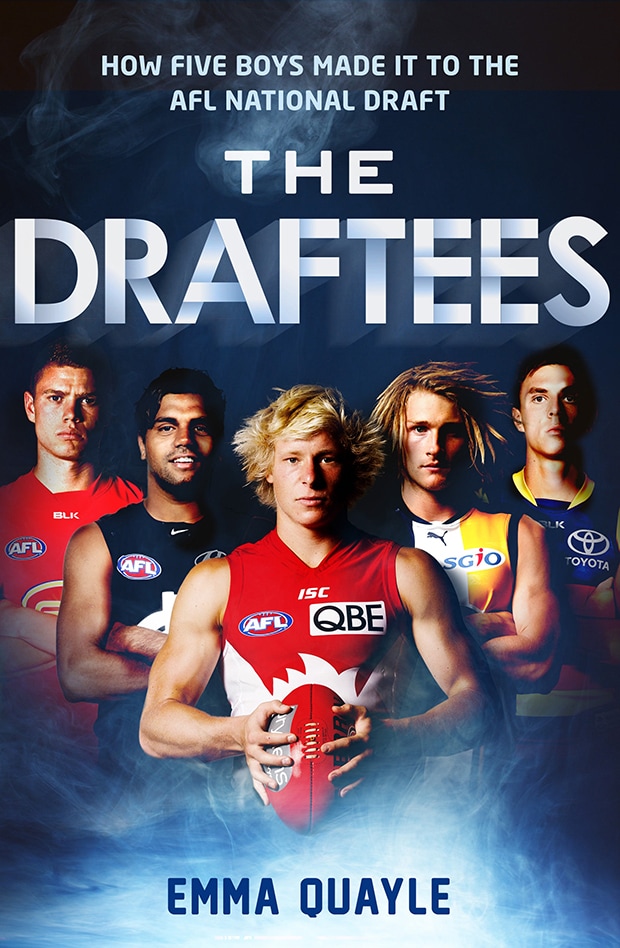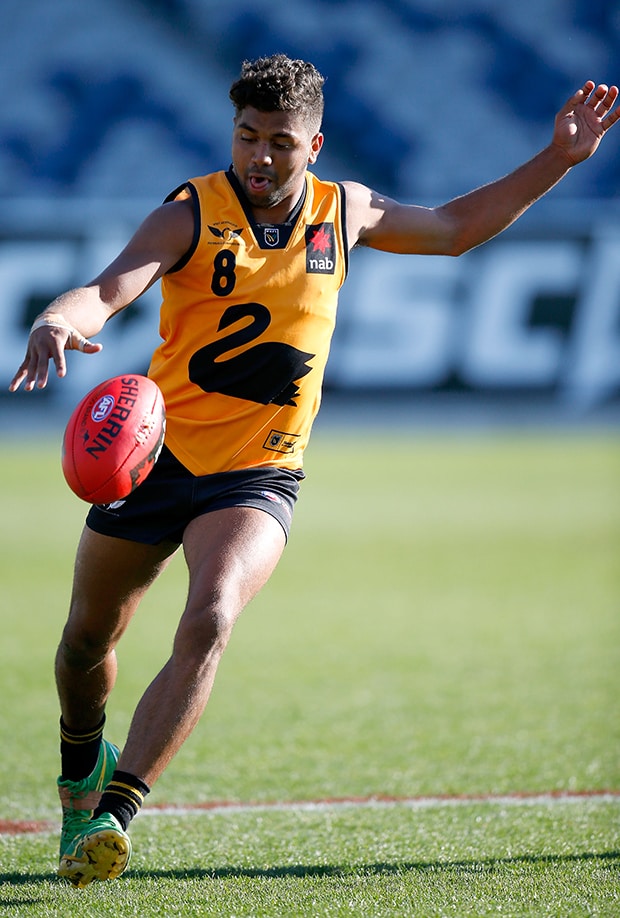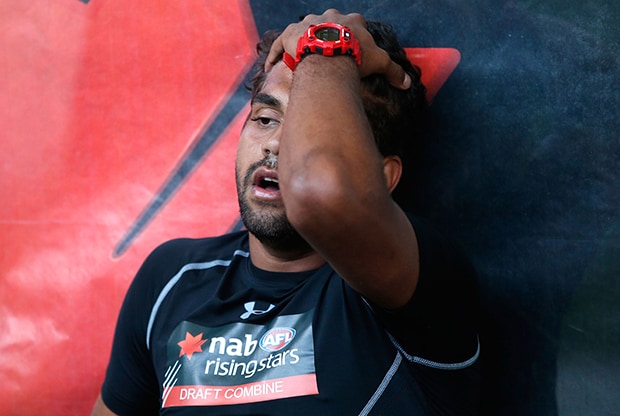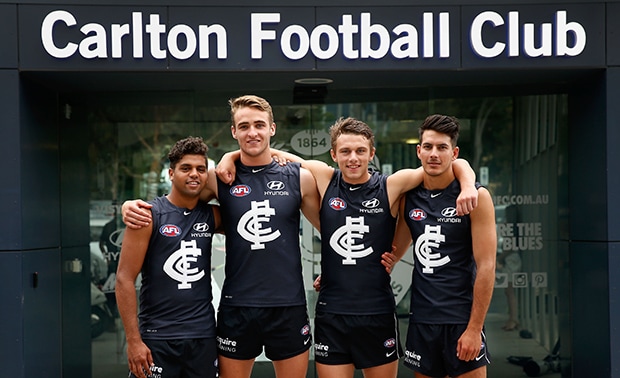Football fans often know very little about the players behind the names called out each year at the AFL National Draft: their hopes, dreams, abilities … and of course their journey to that night that could make their hopes and dreams a reality.
The journey of Carlton's Clem Smith has been explored by senior football writer Emma Quayle in her book The Draftees, released this week by Penguin Random House Australia, in partnership with the AFL.
In The Draftees, Quayle tracks five boys and their stories through 2014, the year they nominate for the AFL National Draft. At the start of the 2015 AFL season, we didn’t know much about Jake Lever, Peter Wright, Isaac Heeney, Tom Lamb or Clem Smith, except that they had been drafted by an AFL club. Hearing their names called out by a recruiter on draft day was the start of their football journey, but it took a lot to get to that point.
About Emma Quayle
Emma Quayle has been a senior sports writer at Melbourne's The Age newspaper since 2001. She has won the Grant Hattam Trophy and, the AFL Players' Association award for excellence in football journalism. She is widely acknowledged as an expert in talent identification.
The Draftees by Emma Quayle
Published by Penguin Random House, Wednesday 26 August, RRP $32.99
Available from all good bookstores

Here's an extract from the book:
Clem hadn’t realised you needed to push the red button, and neither had anyone else, as they watched from the Christies’ living room. The draft was into the 30s by the time Jake lunged for the remote control but Clem’s inevitable first thought - Have I been picked yet? - lasted only a moment. Surely people would have noticed his name scroll across the bottom of the screen and started sending him text messages. Surely his phone would have started ringing.
Clem had slept as far through the morning as he could but not for nearly as long as he’d hoped to, and had woken up feeling nervous. The time difference was helpful - he only had to wait until mid-after- noon for the telecast to start - but nothing helped take his mind off things. Not going out to do some shopping with Leah, not watching TV, not talking to Ani, not standing up, sitting down, pacing up and down the lounge room and around the kitchen table.

Clem Smith in action for WA during the 2014 NAB AFL Under 18 Championship. (Photo: AFL Photos)
I thought it might be West Coast, he thought, but the Eagles had chosen Tom Lamb, then Jackson Nelson at 51. I thought it could be the Bulldogs, he thought next, but by the end of the 40s they had chosen five players who weren’t him. Melbourne? He had always felt like they liked him, but they picked other players, too, and it was then that Clem started to get really, really nervous. Fremantle didn’t pick him at 54, Geelong didn’t pick him, Port Adelaide didn’t pick him, and when Sydney passed on its selection at 57 he wondered if all the other clubs would start doing that now, too. Leah felt like she was going to be sick. Her life was about to change anyway, with Monique, Joey and their two babies moving six hours south to a farm in Munglinup, but Clem not going away would be worse than having to help him pack his things up if it meant he had missed out. Mick couldn’t sit still, frustrated for Clem, at Clem, at everything. Clem started thinking something he had never imagined himself thinking on draft day, not ever: This might not happen. This isn’t going to happen. What am I going to do?
Harry Dear and Jordan Cunico were drafted next, by Adelaide and the Cats, with Carlton up then at pick 60. The Blues had prioritised midfield runners after trading for Kristian Jaksch and Liam Jones, and their list was ordered accordingly, pushing players such as Paddy McCartin, Peter Wright and some of the other taller pros- pects down into the teens. The club would have chosen only Angus Brayshaw, Liam Duggan and Christian Petracca ahead of Boekhorst at pick 17, with Caleb Marchbank, Jayden Laverde, Jordan De Goey and Dillon Viojo-Rainbow next on their list. They wanted pace, they needed it, Boekhorst had it and when recruiting manager Shane Rogers packaged up highlights of the eight best options and showed them to the club’s coaches they all liked the same player he did, making him feel even more confident that Boekhorst would be the right choice. It was possible that the 21-year-old would have made it to the club’s second pick at No. 28, and Rogers’ fears that Essendon would snap him up at pick 20 had eased by the time he got to the draft. But enough clubs had shown interest in him to make him feel uneasy about leaving him there. And regardless, he was the highest- ranked player on his list. So he picked him, with Viojo-Rainbow the player who made it to 28.

Clem Smith at the Draft Combine. (Photo: AFL Photos)
Sixty was Carlton’s third choice, with its fourth and final one coming in at 63. For Rogers, the draft started to get interesting after the second round, in that he found himself crossing more names off the bottom of his list than the top as other teams started calling their names out. He had taken 54 names into the draft, and by late in the third round two of his top 20 were still available: Dean Gore, who the Blues had ranked at No. 11, and Clem, twentieth on their list. Geelong grabbed Gore with pick 55, Port Adelaide drafted Dougal Howard, Sydney passed, Adelaide chose tall forward Dear and Geelong picked Cunico at 59. The Blues’ two selections were effectively back-to-back, with Lions Academy player Harris Andrews and Bulldogs’ father-son pick Zaine Cordy already attached to picks 61 and 62. Rogers wanted to bring at least one developing tall in, liked Jayden Foster and was able to choose him at 63. He also liked Billy Gowers, who missed out on being drafted, and the midfielder was the first person Rogers called once the draft was over. He was already hoping he might get him in the rookie draft, and Billy’s response to being overlooked was the best one he had heard. ‘I said, “I’m sorry, mate, you were the next name on our list,” and he said, “Shane, if you hadn’t picked that kid at 60 you would have been crazy.” He said, “You had to pick him, he’s a gun.’
Who had he picked? ‘Player 215293. Clem Smith. Perth Footy Club and Wesley College.
The Blues liked Clem as a small forward, and they needed someone to play there given the recent departures of Eddie Betts and Jeff Garlett. Pick 60 was in fact the one they had received from Melbourne for trading Garlett there six weeks earlier. They thought Clem had the speed and agility he needed to play in that position, as well as the willingness to chase and tackle. They knew his endurance needed work, but believed he would listen to the coaches and do what he could to improve it. They had been disappointed, like everyone, that he had given away so many free kicks during the national championships and turned up to the combine in such poor shape. His skinfolds had actually gone up further since then to 93. But Rogers was willing to give him some grace: he was a good kid, he was competitive, and he hadn’t played in a few months. ‘Clem has too much talent to let the things he didn’t do well cancel out the things he did really well. He’s been a good player for two years and when they play well as seventeen-year-olds it’s very easy to look at them for too long and start picking out the things they do wrong,’ he said. ‘We love him as a kid, and we think he’s a really good player. We have a lot of confidence in Clem. Everyone gets to the end of the draft and says they can’t believe this player was there or that player was there. But there was a break between rounds just before our pick and I really did have to turn around to our table and say, “Clem Smith surely can’t still be there”.’

Clem Smith (left) is unveiled at the Blues alongside fellow 2014 draftees Jayden Foster, Dillon Viojo-Rainbow and Blaine Boekhorst. (Photo: AFL Photos)
And just like that, Clem was drafted. He did have a club. He hadn’t missed out after all. He didn’t need to work out what had gone wrong, to start over, to try again, to work harder. He was happy, grateful, smiling for the first time all day. He didn’t know if he was ready to get on a plane in two days, fly to the other side of the country and start living in Melbourne, but Carlton had wanted him, chosen him, and he couldn’t wait to get there and get started. More than anything though, he felt relieved. ‘It was close. Way too close. When I thought about the draft and what it would be like, I never thought it would be like that. I never thought it would be so stressful. The clubs were all telling me it was getting harder for me and I didn’t believe them, but I should have. I just want to make Carlton happy now, happy that they picked me. I want to do everything the way they tell me to. I think I have some people to prove wrong.’


